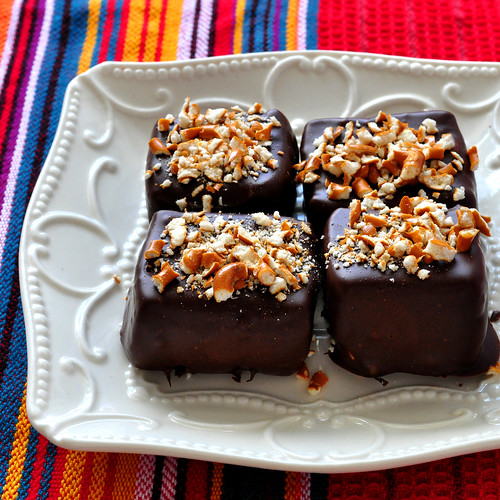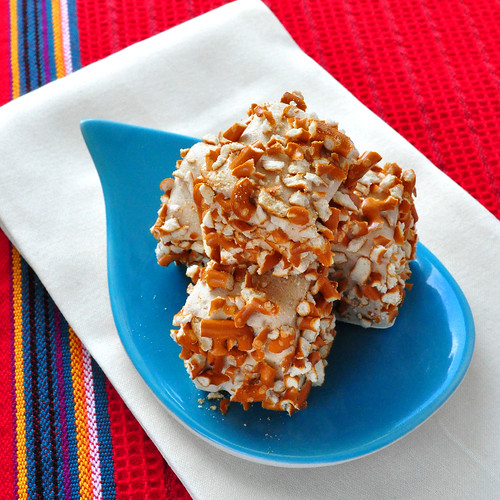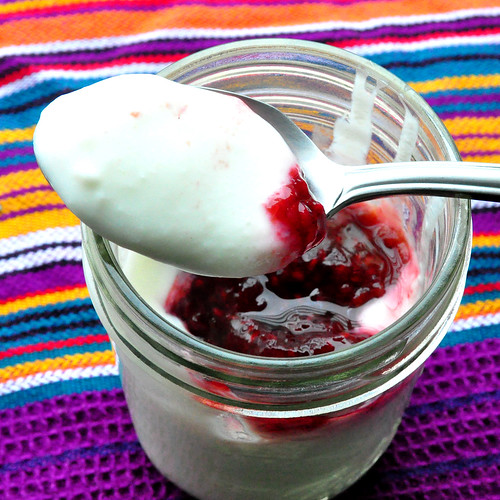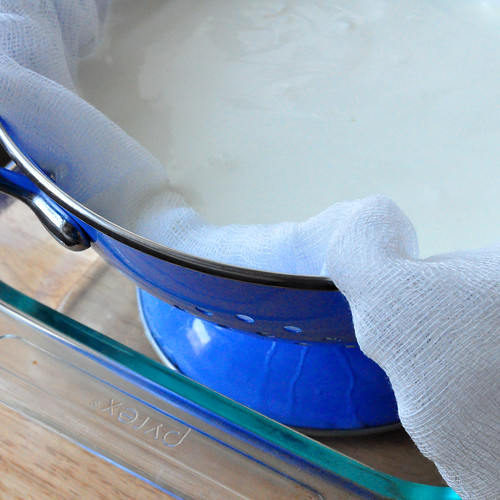
The recipe comes from the kitchn newsletter that I subscribe to and it caught my attention almost right away. The subject was Beer Marshmallows, and doesn't that just sound genius? I had a few bottles of Guinness extra stout sitting in my fridge, so I popped one open and left it on the counter to de-fizz. Once the fluffy mess was whipped up and cut, I thought I'd try a few different presentations, so I dunked a third in chocolate and sprinkled with pretzels, just as the recipe instructed, rolled a few in pretzels skipping the chocolate, and left a few plain, just dunking them in a bit of powdered sugar to de-stickyfy them. While I really liked the chocolate covered ones (I mean it's chocolate, what's not to love), I think the flavor was still a little too faint and it only really came across in the pretzel and plain variations.
But think of the possibilities! Next up, I'm thinking of a wine reduction infused marshmallows in dark chocolate. I'll keep you posted :D

Guinness Marshmallows
Adapted from The Kitchn
Makes about 3 dozen marshmallows, the first few will be neat but you'll be tempted make giant marshmallow blocks by the end, so your results may differ.
For the Bloom:
3 tablespoons (1 ounce or 4 packets) unflavored gelatin
4 teaspoons vanilla extract
2/3 cup (5 ounces) flat Guinness Stout
For the Sugar Syrup:
1 cup (8 ounces) flat Guinness Stout (basically, dump whatever is left in the bottle....unless you've been drinking it, in which case... Come on! It's flat beer!)
1.25 cup (10 ounces) corn syrup or sugar cane syrup
1.5 cup (12 ounces) granulated sugar
pinch salt
Powdered sugar for coating and a bit of vegetable oil for coating the pan
To flatten the beer, open the bottle and let it sit overnight. If you're in a rush, pour it into a bowl and stir the beer with a whisk to release as much of the carbon dioxide as possible. Do not, and I repeat, do NOT attempt to whirr the beer in a blender to de-fizz it. Beer will foam up and leak out everywhere. I won't tell you how I know, but trust me on this one.
Line a 8x8 or 9x9 square cake pan with parchment paper and brush it lightly with vegetable oil. You can try and tape the flaps to the outside of the pan so the paper stays in place when you spoon in the marshmallow or just crease it and fold it over (for some reason I couldn't get the tape to stick to the parchment for very long).
For the bloom, sprinkle the gelatin in the bowl of a stand mixer. Mix the vanilla and flattened beer, and pour this over the gelatin. Whisk or stir until no lumps remain. Set the bowl back into your mixer and fit the mixer with a whisk attachment.
For the sugar syrup, dump the beer into a 6-quart saucepan or larger. I used my large dutch oven, the biggest pot I own, plus I think it's heat retention helps you achieve the high temperatures necessary. Simmer the beer until it's reduced by half, then add in the corn syrup, sugar, and salt. Clip a candy thermometer to the side, or stick your probe thermometer in there. Turn the heat to high and bring the sugar mixture to a boil. As the syrup heats, it will foam up to nearly fill the pan. Keep an eye on it so it doesn't boil over. When the mixture is between 225° and 230°, let it bubble for another 5 minutes and then remove it from heat. You want the syrup to reach somewhere between 240° - 250°. If you're having a hard time getting a read but think you're almost there, turn off the heat, stir down the bubbles really quick and take a read. You'll lose a degree or two, but you'll know for sure where you're at.
With the mixer on low speed, carefully pour the sugar syrup down the side of the bowl into the gelatin bloom. (This was where using my dutch oven became not such a great idea...that sucker is heavy! So if you used yours, you might need to solicit help.) Slowly turn the mixer to high once all the syrup has been added and let it whip for 8-10 minutes, until it looks like glossy meringue and is very thick. Pour the marshmallow into the loaf pan and let it cure, uncovered, for 10-12 hours or overnight.
When the marshmallows are cured, rub the top with a little powdered sugar and turn the marshmallows out onto a cutting board. Rub the top with more powdered sugar. Cut into 18-22 squares of equal size. Marshmallows will keep in a covered container for several weeks.
The original recipe had you dip the 'mellows in chocolate and top them with pretzels, and I tried a few that way, but the chocolate completely overpowers the beer flavor. I tried just pretzels too and that was a bit better, but plain marshmallows were the best. So learn from me and skip the extra work :D


